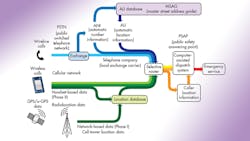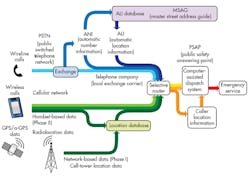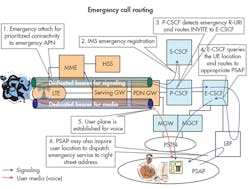Strengthen E911 Device Compliance with VoLTE/IMS Networks
This file type includes high-resolution graphics and schematics when applicable.
The FCC’s network operator rules for wireless Enhanced 911 (E911) is an effort to improve the effectiveness and reliability of wireless E911. With an estimated that 240 million 911 calls made each year, two-thirds of which are made from wireless devices, it’s important that 911 dispatchers are able to gather critical information on wireless 911 calls. This includes methods that provide additional information, such as call location.
To support emergency services for VoLTE subscribers, many new items must be considered from a device and network perspective. The transition from a traditional circuit-switched (CS) network to an all-IP-based network utilizing IMS for voice calls, and the addition of new positioning methods like A-GNSS, OTDOA, and eCID with a new information exchange protocol (LTE Positioning Protocol), all add new dimensions to this mandatory feature. In fact, vendors must now ensure this feature via functional and performance compliance of their devices in a multi-technology environment. As a result, it’s important to emulate and test all aspects of the mobile access and IMS network for efficient VoLTE E911 over IMS.
E911 Rules
Delivering E911 services is an FCC requirement and has been a part of legacy network services for some time. The most important aspect for a single phone number accessing police, fire, and ambulance services is the automatic routing of the call to the correct emergency dispatch center, also known as the public safety answering point (PSAP). In 1996, the FCC issued docket 94-102 that stipulates the specific rules regarding routing and delivery of wireless E911 calls. Network operators and mobile-device manufacturers must comply with three phase requirements:
• Phase 0: All wireless calls will route to a destination that can respond to an emergency. A cell site will not be placed “in service” unless 911 routing has been properly established. Essentially, this is call forwarding.
• Phase I: Delivery of call back number (ANI) and cell-site location information (ALI) to PSAP within 6 minutes. PSAP must make formal request for the services. PSAP must be capable of receiving and utilizing the information.
• Phase II: Same as Phase I except for a more precise location of the caller (300 meters), specifically the latitude and longitude.
In 2011 and again in February of 2015, the FCC updated the stipulations for Phase II of the wireless E911 framework. Because the majority of E911 calls originate from indoors, it’s important for the location of the caller to be accurate. The new rules state that within two years, 95% of indoor E911 calls must communicate an accurate location within 150 m to the PSAP, and 67% of indoor E911 cellular calls must provide location coordinates accurate to 50 m. In five years, this number jumps from 67% to 80%.
A vertical data (z-axis) requirement was also introduced to help locate callers in buildings with multiple floors. The z-axis location is required to be accurate within 3 m.
Traditional E911 Architecture
E911 calls made on landlines or via a CS cellular network are fairly straightforward (Fig. 1). Both wireline and CS wireless calls easily deliver ANI and ALI to the PSAP to meet the Phase I and Phase II FCC regulations.
This is a simple, straightforward task when using a landline, as the call is made from a line with a known and recorded phone number with a fixed or stationary (non-wireless) address. The CS wireless call utilizes GPS and queries the location database to provide the PSAP with the location of the E911 caller.
Transition to IP-based Network
LTE networks can deliver mobile broadband with greater data capacity and lower latency. However, since there’s no circuit-switched voice domain in LTE, the mobile industry has adopted a globally interoperable IP-based voice and video calling solution for LTE, known as VoLTE, which also enables development of new innovative communication services.
VoLTE can leverage the world’s largest mobile user community (the Mobile Subscriber Integrated Services Digital Network, or MSISDN), as well as traditional telecommunication principles like guaranteed end-to-end QoS, support for emergency and regulatory services, global interoperability and mobility, interconnect, and international roaming.
LTE/IMS E911 Architecture
Previously, emergency calls for VoLTE were handled by circuit switch fallback (CSFB), in which the devices fall back to overlapping GSM/WCDMA access, or within the LTE access. The best alternative depends on the radio coverage of the LTE network and the overlapping GSM/WCDMA accesses.
In initial LTE deployments, the overlapping GSM/WCDMA coverage may be more reliable to use for VoLTE emergency calls. However, as the LTE network is gradually built out and tuned, it will be better to handle the emergency calls in the LTE network, as the VoLTE service will be more reliable and faster than the CSFB service.
In some networks, the LTE access may use lower radio frequencies than the overlapping GSM/WCDMA accesses, and in this case, the CSFB alternative isn’t recommended even in initial deployments. That’s because CSFB calls may fail where VoLTE calls will succeed due to the fact that lower radio frequencies have better indoor coverage than higher radio frequencies. SRVCC is also defined for emergency calls over LTE (enhanced SRVCC) so that both SIM- and SIM-less VoLTE calls can be transferred to overlapping GSM/WCDMA coverage in case users move out of LTE coverage.
LTE/IMS E911 Call Flow
Recent advances to LTE/IMS networks deliver a new call flow when routing emergency calls (Fig. 2). LTE Release 9 dictates that devices must meet 3GPP standardized positioning performance tests, which is beneficial for supporting Phase I and Phase II requirements of emergency calls.
As shown in Fig. 2, a dedicated and default bearer is established for IMS signaling and VoLTE calls. Any UE can make an emergency call, provided the network supports it, and no subscription authorization is required for the UE in a home subscriber server (HSS). A mobility management entity (MME) for the emergency configuration data, defined by 3GPP, allows an emergency APN to be defined. This ensures the call is prioritized and enables the call to be routed to the correct PSAP.
LTE Positioning Methods
Location-based services (LBS) are already well-established for both emergency services and infotainment. What all location-based services have in common is finding where the mobile device is actually located. LTE Release 9 provides support for the following location technologies:
• Satellite-based positioning: Assisted global navigation satellite systems (A-GNSS) such as GPS and GLONASS
• Mobile radio cellular positioning: Observed time difference of arrival (OTDOA) and enhanced cell ID (eCID)
• Hybrid methods: Hybrid-GNSS or GNSS + mobile radio cellular positioning like OTDOA
• Control plane (C-Plane) and user plane (U-Plane) session handling: LPP, SUPL 2.0
Continued improvements to these LTE position methods, such as the new Secure User Plane Location (SUPL) 2.0 development, enables VoLTE networks to adhere to FCC Phase II requirements. The SUPL 2.0 for emergency call handling includes the prioritization of emergency SUPL sessions over non-emergency sessions.
SUPL 2.0 includes multiple enhancements over SUPL 1.0, notably support for hybrid location-positioning techniques, support for major global-navigation-satellite-system (GNSS) technologies, area event triggering, and emergency call handling for E911. This is a very important addition to SUPL due to the network migration from circuit-switched voices services to all IP IMS-based VoLTE calls. This represents a significant shift in wireless communications.
In LTE VoLTE-enabled networks, the E911 voice calls could take place over the IP packet data domain; therefore, priority must be assigned to the emergency SUPL session. SUPL 2.0 provides support for the following:
• Any non-emergency SUPL session is immediately aborted when an Emergency SUPL session starts.
• During an emergency SUPL session, any non-emergency SUPL_Init is discarded.
• If there are multiple Emergency SUPL_init messages arriving, then UE first processes the SUPL_Init messages that refer to a E-SLP that’s on a whitelist stored in the UE, and subsequently processes the other SUPL_init messages.
• If more than one Emergency SUPL Init exists, with FQDNs that are on the whitelist, the UE responds according to “first come first serve.”
Testing E911 Over VoLTE
Providing reliable support for E911 with VoLTE service presents new challenges, which has led major carriers to invest in VoLTE E911 testing as part of their device certification process. Meeting these challenges requires state-of-the-art test and certification systems, such as the Rohde & Schwarz TS-LBS and R&S CMW500 Protocol Tester, which can seamlessly address the testing complexities of legacy, current, and future technologies.
Test solutions for emergency calls over LTE/VoLTE must not only support the session initiation protocol (SIP), but also a wide range of LTE signaling procedures that could lead to complex interaction issues during an emergency call. Emergency-call-routing test platforms need a robust, highly reliable, standards-based SIP architecture.
Test procedures must ensure that VoLTE calls are maintained with sufficient quality while concurrently enabling testing of call routing to the PSAP, re-bid by PSAP for precise location after call routing, updating precise position requests, PSAP call back, and more. Testing VoLTE E911 over IMS requires extensive libraries with multiple provisioning interface tools. These libraries of ready-to-use R&D and operator test scenarios plus 3GPP conformance test cases simplify the test process and enable wireless operators to select the options that best meets deployment needs, resulting in timely and responsive E911 management.
Conclusion
The FCC wireless E911 mandate establishes a certain set of criteria that wireless operators must follow. Operators must comply with regulatory requirements for emergency services, including E911 in North America, E112 in Europe and 110 in China, in terms of accuracy as well as speed.
The 3GPP organization has provided clearly defined procedures for emergency calls in Release 9. LTE significantly improves location accuracy with new positioning methods. And with VoLTE rollouts currently taking place, operators are challenged with the need for extensive and complex testing of these IP-based networks to properly support the LTE positioning technologies, ensuring VoLTE E911 works well from the outset.
As LTE networks evolve and expand, so too must the supporting test platforms. Test companies like Rohde & Schwarz provide the advanced LTE test solutions that allow carriers to enhance networks and ensure E911 protocols are secure and operational.
About the Author
Eric Chu
Application Engineer, Product Leader, Protocol Conformance Tests
Eric Chu is a Product Leader for the Rohde & Schwarz Protocol Conformance Test product line. He has more than 13 years of experience in the wireless test & measurement field, specializing in GSM, WCDMA, and LTE protocol analyzer products. Employed at Rohde and Schwarz for more than 10 years, Mr. Chu previously was an Application Engineer at Aeroflex Inc. He holds a B.S. in electrical engineering with a computer engineering option from University of California, Los Angeles.





